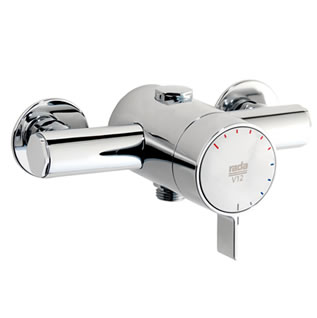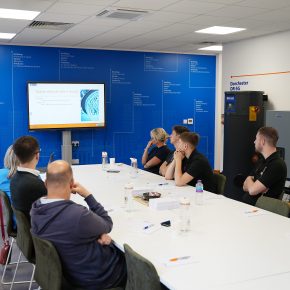
Thermostatic Mixing Valve advancements offer new design opportunities
Many in the industry will remember the high profile Hot Water Burns Like Fire initiative. Over the past decade, there has been much campaigning to raise awareness of the dangers of unregulated hot water and the importance of Thermostatic Mixing Valves in preventing scalding and saving lives. Despite the progress made, BEAMA (the British Electrotechnical and Allied Manufacturers Association), reports that every year around 20 people still die as a result of scalds caused by hot bath water and a further 570 suffer serious scald injuries.
The first thermostatic bath and shower mixer was actually introduced 78 years ago in 1936. What started off as an industry first went on to become a popular offering from most manufacturers with TMVs eventually forming part of the Building Regulations.
Today, some perceive TMVs as a feature to combat waterborne bacteria such as legionella but we must not forget that these clever devices, which control the blend of hot and cold water to leave the outlet at a safe temperature, were developed for safety.
Injury from scalding is on the Department of Health’s Never Events list, and TMVs have proven an extremely effective tool for eliminating this. NHS institutions operate with maximum temperatures of 41°C for hand washing and showers and 44°C for baths. In schools, while there is no legally prescribed temperature setting for TMVs, there is a legal duty of care to ensure facilities are safe.
The temperature of the hot water at point of use should be risk assessed and manufacturers would suggest a safe delivery of water at temperatures around 43°C. This can be done efficiently using a TMV, which also complies with Building Bulletin 87, 2nd Edition Guideline for Environmental Design in Schools as recommended by BEAMA and the BRE.
Advancements in TMVs have led to the availability of BuildCert TMV3 (Healthcare and Commercial Thermostatic Sector) approved digital products alongside more traditional mechanical TMVs. In reality, the safety of hot water baths, taps and shower facilities within commercial environments forms part of a whole raft of other key factors in the specification process.
For example, many commercial washrooms face heavy usage a busy gym shower could be in use for up to 17 hours per day. Typically, there is also a requirement for a reduction in water consumption and energy bills, system maintenance and compliance. Estates teams need safe and robust systems which provide these benefits and overall time savings for facilities staff.
This is an area where forward-thinking manufacturers are adding real value. State-of-the-art, intelligent digital products can be programmed by facilities management personnel to provide bespoke duty flushing or thermal disinfection regimes, and utilise manual or touch-free on/off controls for infection control support a key benefit in healthcare environments. These features eliminate the need for staff to manually flush outlets and having to update paper records, saving precious time and resource. While the ability to programme timed-flow rates helps to reduce overall water and energy consumption.
Taking this a step further, it is now also possible to connect and link digital TMVs that are used to service taps and showers together in a network. Using the software available, all functions can be monitored and re-programmed from a remote location. In addition to this, if necessary, information on usage and regimes, with some systems capable of logging and storing 12 months of data history, can be extracted for guideline compliance.
Electronically controlled features such as PIR (passive infrared), occupancy sensors, extractor fans and system key switches can also connect with the digital TMV to minimise energy consumption and improve efficiency.
The provision of information recording and monitoring capabilities such as this represents a positive step forward since the first TMV was introduced over 70 years ago and assists compliance and cost control measures in commercial washrooms today.
Latest news

24th April 2024
The lowdown on Origin’s New Soho Offering
Origin’s Soho External Door is the first launch in its new generation of products, setting a higher standard for the fenestration industry.
Posted in Access Control & Door Entry Systems, Aluminium Products, Architectural Ironmongery, Articles, Building Industry News, Building Products & Structures, Building Systems, Doors, Innovations & New Products, Posts, Restoration & Refurbishment, Retrofit & Renovation, Security and Fire Protection
24th April 2024
Mitsubishi Electric welcomes new code of conduct for smart appliances
Mitsubishi Electric welcomes a new code of conduct on energy smart appliances which the European Union (EU) announced yesterday at the Hannover Fair in Germany.
Posted in Air Conditioning, Articles, Building Industry Events, Building Industry News, Building Products & Structures, Building Regulations & Accreditations, Building Services, Exhibitions and Conferences, Facility Management & Building Services, Heating Systems, Controls and Management, Heating, Ventilation and Air Conditioning - HVAC, Plumbing, Retrofit & Renovation, Seminars, Sustainability & Energy Efficiency
24th April 2024
Hamworthy Heating expands CIBSE approved CPD modules with new hot water series
Hamworthy Heating, technical experts in commercial heating and hot water products, announce the expansion of its market leading CIBSE approved Continuing Professional Development (CPD) portfolio with the launch of three new learning modules.
Posted in Articles, Building Industry Events, Building Industry News, Building Products & Structures, Building Services, Continuing Professional Development (CPD's), Facility Management & Building Services, Heating Systems, Controls and Management, Heating, Ventilation and Air Conditioning - HVAC, Plumbing, Retrofit & Renovation, Seminars, Training
24th April 2024
New technology partnership brings Passivent ventilation products to IESVE
Passivent has partnered with Integrated Environmental Solutions (IES) to make a number of its products available to model within the Virtual Environment (VE) platform IESVE.
Posted in Air Conditioning, Articles, Building Industry News, Building Products & Structures, Building Services, Facility Management & Building Services, Heating, Ventilation and Air Conditioning - HVAC, Information Technology, Innovations & New Products, Posts, Retrofit & Renovation, Roofs, Ventilation
 Sign up:
Sign up: